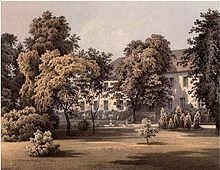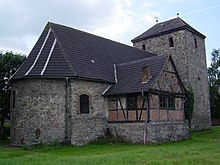Emden (Altenhausen)
|
Emden
Community Altenhausen
Coordinates: 52 ° 14 ′ 23 " N , 11 ° 16 ′ 59" E
|
|
|---|---|
| Height : | 107 m |
| Area : | 16.43 km² |
| Residents : | 305 (December 31, 2008) |
| Population density : | 19 inhabitants / km² |
| Incorporation : | January 1, 2010 |
| Postal code : | 39343 |
| Area code : | 039052 |
Emden is a district of the Altenhausen community in the Börde district in Saxony-Anhalt .
geography
Emden belongs to the Magdeburger Börde and therefore has one of the most fertile soils in Germany. The village is surrounded by a nature reserve to the east, west and north. The Altmark connects to the extensive forests in the north, the Flechtinger mountain range .
The place is located in the valley of the Beber river , known in Emden as "Bever" , which has three springs. On its 13-kilometer route to its confluence with the Ohre , it is first fed on the Emdener Flur by the Krumbeek and the Riehe, before it winds its way from the west to the southern location of Emden. It continues on its way to the Papenteich before flowing on the Alvensleber Flur towards Bebertal .
history
The place was first mentioned in 1022 (as Emmode ). The name changed a few times (Emmedha, Emede, Embden) until it got its current version. According to Peter Wilhelm Behrends , the place is one of the oldest Saxon settlements in the region.
There is evidence that the region around Emden was settled over 5,000 years ago. Numerous finds (barrows, remains of settlements and a stool grave ) point to life in this region at that time.
Originally there were two villages: Groß Emden and Klein Emden. The latter fell desolate due to emigration around the 13th century . The exact causes of the migration are unknown. It is assumed that the residents moved to nearby Groß Emden (i.e. today's Emden) in order to avoid arson or disease.
From the 11th to 14th centuries, Emden was predominantly owned by the Michaeliskloster Hildesheim and the Alt-Haldensleben monastery . At the end of the 15th century it came into the possession of the Counts von der Schulenburg auf Altenhausen , who lived and managed the manor Emden until it was expropriated in September 1945 . Since 1485, a Schulenburg-Emden line was formed several times, but it went out three times in the male line, with Emden falling back to the Schulenburg-Altenhausen line.
On September 30, 1928, the main part of the manor district of Emden was united with the rural community of Emden and a small part with the rural community of Altenhausen. Today the manor is privately owned. A usage concept for the historic building is not known.
The Emden cantor, teacher and local researcher Franz Bock (1879–1951) collected data on local and family history in the "Emmode" chronicle. It describes the first settlement of the region before the Christian era up to the individual farms and their owners up to 1937. The chronicle is updated.
By tradition, the municipality did not have a coat of arms, but a seal. This is borrowed from what has been handed down from the chronicle. The local seal shows a woman in traditional rural costume. She has a rake in one hand. The ears of wheat indicate agriculture, which still plays a major role in Emden today. The rushes are reminiscent of the village pond in Oberdorf, which no longer exists today. Furthermore, a flower can be seen in the seal, which indicates the close connection with that of the Schulenburg in Emden.
On January 1, 2010, the previously independent municipalities of Emden and Ivenrode merged with the municipality of Altenhausen to form the new municipality of Altenhausen . Due to the central location and the historical connection of all three districts, Altenhausen was chosen as the new place name for the newly created community.
Population development
Contrary to the population figures from the State Statistical Office, the actual population (residents only with main residence) was 370 as of December 31, 2008. Research showed that the residents were incorrectly assigned to Emden in East Frisia , which is why this population decline only appears in the statistics. Attempts are currently being made to clean up the statistics.
Economy and Infrastructure
The village essentially has four streets in north-south direction and four in east-west direction. The district road 1149 connects the federal road 245 in the south with the Landstrasse 42 in the north of Emden. Within the locality, this road is called Hauptstrasse (formerly: Breite Strasse).
A little more than half of the village is connected to the central sewage network, the remaining properties are disposed of in a decentralized manner. The Wastewater Association Nördliche Börde intends to fully connect the site to the central wastewater network within the next few years. As a result of this intended measure, the municipality is waiting to renovate the streets and sidewalks in order not to have to bear double costs. Most of this work was done in 2009. The sewage network was completed and the main street with ancillary facilities was completely redesigned.
In addition to some farmers, the Emden Agricultural Cooperative, Stahlbau Emden and a tavern are to be mentioned as commercial enterprises: the Café Emmode. The old Beverkrug with over three hundred years of history is no longer in operation. The owners of Café Emmode also run a small grocery store where residents can buy basic groceries. The majority of the residents work outside the boundaries of the district.
Due to the lower number of inhabitants and structural adjustments, the children are enrolled in the Bregenstedt primary school and can then choose whether they want to attend the secondary school in Erxleben or the grammar school in Haldensleben . School buses and public buses drive to the site several times a day.
Due to its idyllic location, the municipality relies more on the protection of the landscape and gentle tourism than on the creation of commercial areas. In this way, the place retains its historically grown face.
Emden (Altenhausen) is located on the Haldensleben – Weferlingen railway line, which is used exclusively for freight traffic .
Culture and sights
The old four-sided farms, some of which still have sandstone-spanned gate entrances, are particularly worth seeing. There are two types in Emden: the Thuringian court and the Franconian court.
The manor house in which Johann Matthias von der Schulenburg was born can be viewed from the outside. It was built around 1530 and rebuilt in its present form in the middle of the 17th century. Above the entrance of the simple two-storey building with ten by five axes is the alliance coat of arms of the von der Schulenburg / von Stammern . Inside, the original rooms have been reduced in size for use as a nursing home. The manor house currently has 22 rooms. The varied stucco work is still well preserved. In the basement, lush flower and fruit stucco plastering was installed in some rooms , two rooms have probably still received the ceiling designs from the 17th century; two more rooms on the upper floor are decorated with classical stucco work. The garden of the manor house was originally laid out in the style of an English landscape garden and extends to the banks of the Beber (or Bever ). The old farm buildings, which were all rebuilt in red sandstone after a fire in 1793, have also been partially preserved. The manor house is one of the castles in Eastern Westphalia .
St. George's Church in Emden is the only church in the district to have received its medieval floor plan. It is a listed building; on its north side is the so-called Prieche: a half-timbered extension whose compartments still reveal medieval brick infills. According to ancient beliefs, this special type of infill was supposed to protect against evil and evil spirits. The family crypt of those from the Schulenburg under the apse is no longer accessible.
There was a very old chestnut in the churchyard, the huge crown of which was particularly beautiful to look at during the flowering season in May. During the storm at Pentecost 2007 it was badly damaged and professionally cut back. As a result, she lost its size and beauty.
The nature reserves with Papenteich, Busch, Finkenberg and Lindenberg as well as Missionsplatz offer good opportunities for day trips.
Emden is a station on the Elbe-Aller cycle path .
Regular events
In contrast to the neighboring towns that invite you to the Easter bonfire, the traditional May bonfire takes place in Emden on the night of April 30th to May 1st. First of all, the residents meet in the center of the village at the maypole that has just been erected, and then move through the village with a torchlight to the fairground and light the piled wood.
Every year on Ascension Day , the traditional mission festival is celebrated on the mission square in the forest under old oak trees (with interruptions since 1863). In addition, people from all over the region come together to listen to edifying words and the reports of the missionaries at an open-air service.
On the old sports field on the Beber, about 1 km upstream from Emden, an anniversary celebration with a music band under an oak tree between poplars has turned into a festival of electronic dance culture. Independent of the many other festivals with the same ulterior motive. "Krach am Bach" is the annual sound spectacle over a weekend in mid-August, bringing together many local, national and international artists and musicians, dance enthusiasts and onlookers.
Personalities
The most outstanding personality of Emden is Matthias Johann Graf von der Schulenburg (1661–1747). On behalf of the Republic of Venice , he defended the fortress of Corfu and thus saved Central Europe from the invasion of the Turks. Werner von der Schulenburg wrote the historical novel The King of Corfu about his famous ancestor.
His sister Ehrengard Melusine von der Schulenburg (1667-1743) was the mistress of King George I of England. His brother Daniel Bodo von der Schulenburg was a lieutenant general from the Electorate of Saxony.
The Prussian Lieutenant General Hermann von der Schulenburg (1794–1860) was born here, as was his son, the Prussian officer and later Capuchin Father Hermann von der Schulenburg (1829–1865).
Cantor Franz Bock (1879–1951) was a teacher, cantor, sexton and organist in Emden. He made a national name for himself in his role as a local researcher. In addition to detailed research into regional history, his achievements include his works “History of the Neu-Haldensleben District ” (1920) and the book “Emmode - Geschichte einer Dorfes” (1937), which provides an orientation for the creation of other local chronicles in the region.
literature
- Kurt Bartels: Familienbuch Emden (district Börde), 1684 to 1800. Leipzig: AMF 2008 (= Central German local family books of the AMF 43)
swell
- Peter Wilhelm Behrends: Neu-Haldenslebische Kreis-Chronik. 1. u. Part 2. 1824 and 1826
- Franz Bock: Emmode - history of a village. 1937
- Mathias Weiß (acting local writer for the municipality of Emden): Collection of local history. (started in 1995, since then continuously managed and constantly expanded)
- Kurt Bartels, family book Emden 1684–1800 (district Börde). 1684 to 1800. Central German local family books of the AMF, Leipzig 2008
Individual evidence
- ↑ Administrative region of Magdeburg (Ed.): Official Gazette of the Government of Magdeburg . 1928, ZDB -ID 3766-7 , p. 226 .
- ↑ StBA: Area changes from January 01 to December 31, 2010
Web links
- Manor house Emden
- Rittergut Emden (after Alexander Duncker , around 1875) (PDF; 324 kB)


